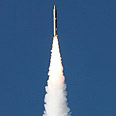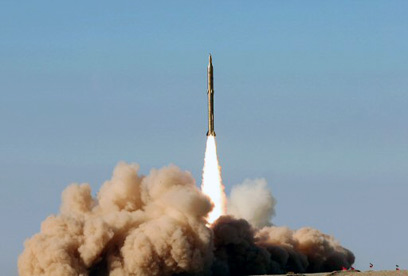
Iran has test-fired a new generation of surface-to-surface missiles, state television reported on Wednesday.
Iranian Defense Minister Mostafa Mohammad Najjar told the TV station that the missile, named Sejil, is a swift missile produced by the Iranian aerospace industries, which are subject to his office.
He did not say when the missile was tested, but claimed that it was a "two-stage missile with two engines driven by solid fuel" and "a highly unusual ability". He failed to elaborate on the missile's range.
Such a test could possibly point to the fact that Tehran has managed to develop a surface-to-surface missile on its own using solid fuel, enabling the Islamic Republic to be more prepared for launching than with a missile driven by liquid fuel.
Another advantage is the speed needed to place the launcher and prepare it for launching.
The Iranian defense minister clarified that "the missile test was carried out as part of Iran's deterrence and defense doctrine and strategy."
According to Najjar, "The Sejil missile test was planned a year ago and has nothing to do with the recent developments in the region."

'New generation' (Photo: AFP)
The reports came a day after Iranian media said the elite Revolutionary Guards had tested a new missile, named Samen, near the Iraqi border.
"Iran successfully test-fires new generation of ground-to- ground missiles," state television said in a scrolling headline.
Another Iranian channel, the English-language Press TV, said the Sejil missile was of a type that used combined solid fuel and described it as a "deterrent".
"Launch aimed at clarifying Iran's conventional missile aims," Press TV said in a scrolling headline.
The Press TV newscaster said the missile had two stages and showed the Islamic state's capability to "defend its soil".
Iran's armed forces have staged frequent maneuvers in recent months, coinciding with speculation of possible US or Israeli strikes against the Islamic Republic over its disputed nuclear ambitions.
The United States and its Western allies suspect Iran is seeking to build atomic bombs, a charge Tehran denies.
Iran has said it would respond to any attack on its territory by targeting US interests and Washington's ally Israel, as well as closing the Strait of Hormuz, a vital route for world oil supplies.
Reports don’t always match ability
The Iranians from time to time take pride in technological achievements in the arms industry and military fields, mostly in a bid to convey a warning to Western countries that the Islamic Republic is prepared for any scenario of war un the region, should they decide to attack Iran over its refusal to halt its controversial nuclear program.
Many times, however, the reports on Iranian media do not match the actual capabilities of the discussed weapons.
In July, a senior US officer told CNN that Iranian reports on its missile tests were false. The network quoted him saying that Iran had not conducted trials with long-range missiles, as it had claimed.
The officer said the US believes Iran had fired seven short to medium-range missiles. US intelligence reports stated that one of the missile launches was not successful, and it was fired by the Iranians. The Iranian news agency that generally publishes documentation of drills of this sort has not published any new photos from the large-scale launch that was allegedly held by the Iranian Revolutionary Guard.
The only documentation of the event was published by the Revolutionary Guards' news agency, an irregularity in drills such as this, which are normally covered by nationwide press.
Earlier, a Ynet inquiry revealed that the Revolutionary Guards doctored at least one photo of the missile test conducted in the Persian Gulf and "added" at least one missile launching that never took place.
The photos were sent to the news agencies by the Revolutionary Guards and were published by media outlets worldwide, including Israel. In a videotape of the Iranian missile testing, which was shot from a slightly different angle, three missiles can be seen launched, while a fourth remains on the ground.















